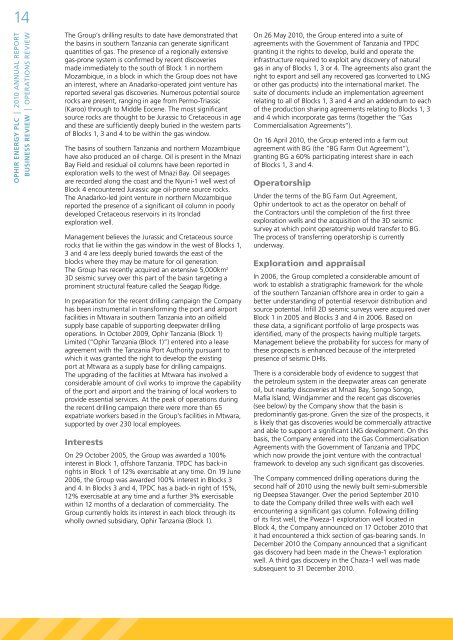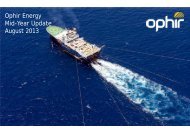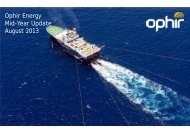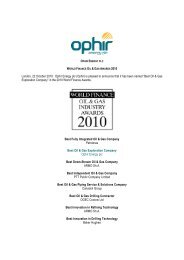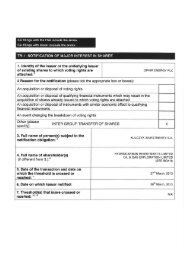Annual Report 2010 - Ophir Energy
Annual Report 2010 - Ophir Energy
Annual Report 2010 - Ophir Energy
Create successful ePaper yourself
Turn your PDF publications into a flip-book with our unique Google optimized e-Paper software.
14<br />
<strong>Ophir</strong> energy plc | <strong>2010</strong> ANNUAL REPORT<br />
BUsiness review | OPERATiONs REviEw<br />
The Group’s drilling results to date have demonstrated that<br />
the basins in southern Tanzania can generate significant<br />
quantities of gas. The presence of a regionally extensive<br />
gas-prone system is confirmed by recent discoveries<br />
made immediately to the south of Block 1 in northern<br />
Mozambique, in a block in which the Group does not have<br />
an interest, where an Anadarko-operated joint venture has<br />
reported several gas discoveries. Numerous potential source<br />
rocks are present, ranging in age from Permo-Triassic<br />
(Karoo) through to Middle Eocene. The most significant<br />
source rocks are thought to be Jurassic to Cretaceous in age<br />
and these are sufficiently deeply buried in the western parts<br />
of Blocks 1, 3 and 4 to be within the gas window.<br />
The basins of southern Tanzania and northern Mozambique<br />
have also produced an oil charge. Oil is present in the Mnazi<br />
Bay Field and residual oil columns have been reported in<br />
exploration wells to the west of Mnazi Bay. Oil seepages<br />
are recorded along the coast and the Nyuni-1 well west of<br />
Block 4 encountered Jurassic age oil-prone source rocks.<br />
The Anadarko-led joint venture in northern Mozambique<br />
reported the presence of a significant oil column in poorly<br />
developed Cretaceous reservoirs in its Ironclad<br />
exploration well.<br />
Management believes the Jurassic and Cretaceous source<br />
rocks that lie within the gas window in the west of Blocks 1,<br />
3 and 4 are less deeply buried towards the east of the<br />
blocks where they may be mature for oil generation.<br />
The Group has recently acquired an extensive 5,000km 2<br />
3D seismic survey over this part of the basin targeting a<br />
prominent structural feature called the Seagap Ridge.<br />
In preparation for the recent drilling campaign the Company<br />
has been instrumental in transforming the port and airport<br />
facilities in Mtwara in southern Tanzania into an oilfield<br />
supply base capable of supporting deepwater drilling<br />
operations. In October 2009, <strong>Ophir</strong> Tanzania (Block 1)<br />
Limited (“<strong>Ophir</strong> Tanzania (Block 1)”) entered into a lease<br />
agreement with the Tanzania Port Authority pursuant to<br />
which it was granted the right to develop the existing<br />
port at Mtwara as a supply base for drilling campaigns.<br />
The upgrading of the facilities at Mtwara has involved a<br />
considerable amount of civil works to improve the capability<br />
of the port and airport and the training of local workers to<br />
provide essential services. At the peak of operations during<br />
the recent drilling campaign there were more than 65<br />
expatriate workers based in the Group’s facilities in Mtwara,<br />
supported by over 230 local employees.<br />
Interests<br />
On 29 October 2005, the Group was awarded a 100%<br />
interest in Block 1, offshore Tanzania. TPDC has back-in<br />
rights in Block 1 of 12% exercisable at any time. On 19 June<br />
2006, the Group was awarded 100% interest in Blocks 3<br />
and 4. In Blocks 3 and 4, TPDC has a back-in right of 15%,<br />
12% exercisable at any time and a further 3% exercisable<br />
within 12 months of a declaration of commerciality. The<br />
Group currently holds its interest in each block through its<br />
wholly owned subsidiary, <strong>Ophir</strong> Tanzania (Block 1).<br />
On 26 May <strong>2010</strong>, the Group entered into a suite of<br />
agreements with the Government of Tanzania and TPDC<br />
granting it the rights to develop, build and operate the<br />
infrastructure required to exploit any discovery of natural<br />
gas in any of Blocks 1, 3 or 4. The agreements also grant the<br />
right to export and sell any recovered gas (converted to LNG<br />
or other gas products) into the international market. The<br />
suite of documents include an implementation agreement<br />
relating to all of Blocks 1, 3 and 4 and an addendum to each<br />
of the production sharing agreements relating to Blocks 1, 3<br />
and 4 which incorporate gas terms (together the “Gas<br />
Commercialisation Agreements”).<br />
On 16 April <strong>2010</strong>, the Group entered into a farm out<br />
agreement with BG (the “BG Farm Out Agreement”),<br />
granting BG a 60% participating interest share in each<br />
of Blocks 1, 3 and 4.<br />
Operatorship<br />
Under the terms of the BG Farm Out Agreement,<br />
<strong>Ophir</strong> undertook to act as the operator on behalf of<br />
the Contractors until the completion of the first three<br />
exploration wells and the acquisition of the 3D seismic<br />
survey at which point operatorship would transfer to BG.<br />
The process of transferring operatorship is currently<br />
underway.<br />
Exploration and appraisal<br />
In 2006, the Group completed a considerable amount of<br />
work to establish a stratigraphic framework for the whole<br />
of the southern Tanzanian offshore area in order to gain a<br />
better understanding of potential reservoir distribution and<br />
source potential. Infill 2D seismic surveys were acquired over<br />
Block 1 in 2005 and Blocks 3 and 4 in 2006. Based on<br />
these data, a significant portfolio of large prospects was<br />
identified, many of the prospects having multiple targets.<br />
Management believe the probability for success for many of<br />
these prospects is enhanced because of the interpreted<br />
presence of seismic DHIs.<br />
There is a considerable body of evidence to suggest that<br />
the petroleum system in the deepwater areas can generate<br />
oil, but nearby discoveries at Mnazi Bay, Songo Songo,<br />
Mafia Island, Windjammer and the recent gas discoveries<br />
(see below) by the Company show that the basin is<br />
predominantly gas-prone. Given the size of the prospects, it<br />
is likely that gas discoveries would be commercially attractive<br />
and able to support a significant LNG development. On this<br />
basis, the Company entered into the Gas Commercialisation<br />
Agreements with the Government of Tanzania and TPDC<br />
which now provide the joint venture with the contractual<br />
framework to develop any such significant gas discoveries.<br />
The Company commenced drilling operations during the<br />
second half of <strong>2010</strong> using the newly built semi-submersible<br />
rig Deepsea Stavanger. Over the period September <strong>2010</strong><br />
to date the Company drilled three wells with each well<br />
encountering a significant gas column. Following drilling<br />
of its first well, the Pweza-1 exploration well located in<br />
Block 4, the Company announced on 17 October <strong>2010</strong> that<br />
it had encountered a thick section of gas-bearing sands. In<br />
December <strong>2010</strong> the Company announced that a significant<br />
gas discovery had been made in the Chewa-1 exploration<br />
well. A third gas discovery in the Chaza-1 well was made<br />
subsequent to 31 December <strong>2010</strong>.


